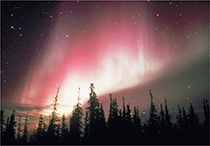The Thermosphere
The outermost layer of the atmosphere, the thermosphere (THUR moh sfeer), begins at an altitude of about 80 kilometers and extends outward into space. No boundary marks the end of the atmosphere. Instead, the thin air of the thermosphere gradually merges with space. In the thermosphere, temperature increases rapidly with altitude, from about −90°C to more than 1000°C. Recall from physics that temperature is a measure of the average kinetic energy of molecules. Because gas molecules in the thermosphere absorb solar radiation and move very fast, the temperature is quite high.
The Ionosphere
The ionosphere (eye AHN uh sfeer) is not a distinct layer of the atmosphere. Rather, it is a region of charged particles, or ions, that overlaps the lower thermosphere. In the ionosphere, molecules of nitrogen and oxygen lose one or more electrons as they absorb high-energy wavelengths of solar radiation. The molecules become positively charged ions. These ions are most dense between the altitudes of 80 and 400 kilometers. At these high altitudes, certain radio waves sent from Earth's surface, such as AM radio waves, bounce off ions and travel back to Earth. You can often hear AM radio stations from very far away at night because the sun's radiation is blocked by Earth. The ions start to recombine at night, allowing AM radio waves to travel farther.
One of nature's most spectacular displays occurs in the ionosphere. An aurora, shown in Figure 6, is a colorful display of light in the sky, produced when charged particles from the sun are attracted to Earth's magnetic poles. There, these particles cause ions in the ionosphere to glow. In the Northern Hemisphere, these displays are called the aurora borealis, or Northern Lights.
Figure 6 Auroras provide spectacular displays of light in the polar regions. Auroras are produced by glowing ions in the ionosphere.

Section 24.1 Assessment
Reviewing Concepts
 How does the atmosphere protect life on Earth?
How does the atmosphere protect life on Earth? What are the two major gases in Earth's atmosphere?
What are the two major gases in Earth's atmosphere? How does air pressure change with altitude?
How does air pressure change with altitude? List the major layers of the atmosphere in order, beginning with the layer closest to Earth's surface.
List the major layers of the atmosphere in order, beginning with the layer closest to Earth's surface.
Critical Thinking
Predicting How might human health be affected if the ozone layer suddenly became thinner?
Comparing and Contrasting Compare the way temperature changes with altitude in the mesosphere and in the thermosphere.
Math Practice
If the temperature is 10°C at an altitude of 1000 meters, what would the temperature be on top of a nearby 5000-meter mountain? (Hint: Assume that temperature falls 6.5°C per kilometer.)
About how much oxygen would there be in a 1000-m3 volume of dry air?





